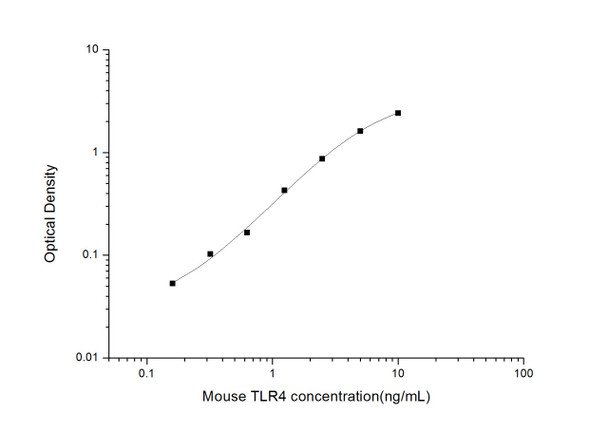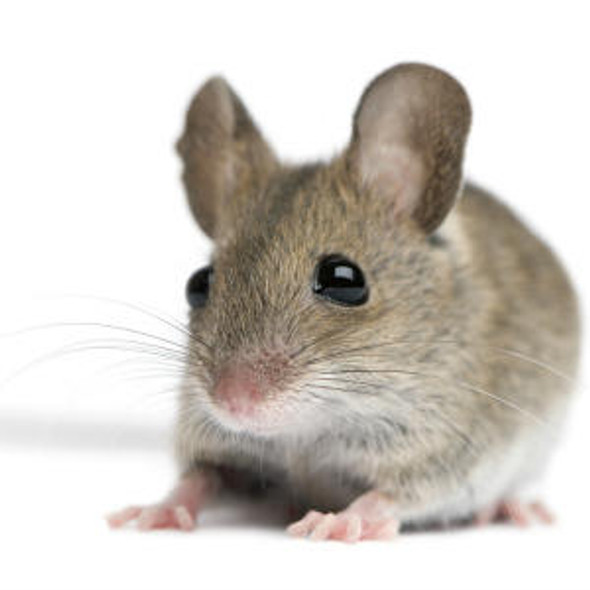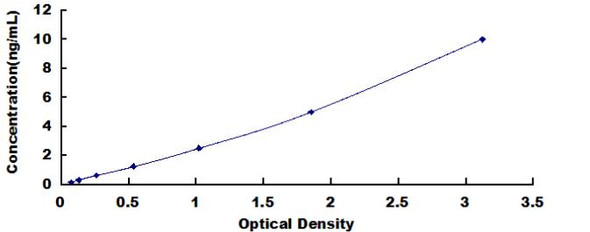Mouse Immunology ELISA Kits
Mouse TLR4 (Toll-Like Receptor 4) ELISA Kit (MOES01697)
- SKU:
- MOES01697
- Product Type:
- ELISA Kit
- Size:
- 96 Assays
- Uniprot:
- Q9QUK6
- Sensitivity:
- 0.09ng/mL
- Range:
- 0.16-10ng/mL
- ELISA Type:
- Sandwich
- Synonyms:
- TLR-4, ARMD10, CD284, TOLL
- Reactivity:
- Mouse
- Sample Type:
- Serum, plasma and other biological fluids
- Research Area:
- Immunology
Description
| Assay type: | Sandwich |
| Format: | 96T |
| Assay time: | 4.5h |
| Reactivity: | Mouse |
| Detection Method: | Colormetric |
| Detection Range: | 0.16-10 ng/mL |
| Sensitivity: | 0.10 ng/mL |
| Sample Volume Required Per Well: | 100µL |
| Sample Type: | Serum, plasma and other biological fluids |
| Specificity: | This kit recognizes Mouse TLR4 in samples. No significant cross-reactivity or interference between Mouse TLR4 and analogues was observed. |
This ELISA kit uses Sandwich-ELISA as the method. The micro ELISA plate provided in this kit has been pre-coated with an antibody specific to Mouse TLR4. Standards or samples are added to the appropriate micro ELISA plate wells and combined with the specific antibody. Then a biotinylated detection antibody specific for Mouse TLR4 and Avidin-Horseradish Peroxidase (HRP) conjugate are added to each micro plate well successively and incubated. Free components are washed away. The substrate solution is added to each well. Only those wells that contain Mouse TLR4, biotinylated detection antibody and Avidin-HRP conjugate will appear blue in color. The enzyme-substrate reaction is terminated by adding Stop Solution and the color turns yellow. The optical density (OD) is measured spectrophotometrically at a wavelength of 450 nm ± 2 nm. The OD value is proportional to the concentration of Mouse TLR4. The concentration of Mouse TLR4 in samples can be calculated by comparing the OD of the samples to the standard curve.
| UniProt Protein Function: | TLR4: Cooperates with LY96 and CD14 to mediate the innate immune response to bacterial lipopolysaccharide (LPS). Acts via MYD88, TIRAP and TRAF6, leading to NF-kappa-B activation, cytokine secretion and the inflammatory response. Also involved in LPS- independent inflammatory responses triggered by Ni(2+). These responses require non-conserved histidines and are, therefore, species-specific. Belongs to the lipopolysaccharide (LPS) receptor, a multi-protein complex containing at least CD14, LY96 and TLR4. Binding to bacterial LPS leads to homodimerization. Interacts with LY96 via the extracellular domain. Interacts with MYD88 and TIRAP via their respective TIR domains. Interacts with NOX4. Interacts with CNPY3. Interacts with HSP90B1. The interaction with both CNPY3 and HSP90B1 is required for proper folding in the endoplasmic reticulum. Highly expressed in placenta, spleen and peripheral blood leukocytes. Detected in monocytes, macrophages, dendritic cells and several types of T-cells. Belongs to the Toll-like receptor family. 3 isoforms of the human protein are produced by alternative splicing. |
| UniProt Protein Details: | Protein type:Receptor, misc. ; Membrane protein, integral Cellular Component: cell surface; cytoplasm; external side of plasma membrane; integral to plasma membrane; intrinsic to plasma membrane; lipid raft; lipopolysaccharide receptor complex; perinuclear region of cytoplasm; plasma membrane Molecular Function:lipopolysaccharide binding; lipopolysaccharide receptor activity; phosphoinositide 3-kinase binding; protein binding; receptor activity Biological Process: activation of innate immune response; activation of MAPK activity; activation of NF-kappaB transcription factor; astrocyte development; B cell proliferation during immune response; defense response to Gram-negative bacterium; detection of lipopolysaccharide; I-kappaB phosphorylation; innate immune response; innate immune response-activating signal transduction; interferon-gamma production; interleukin-1 beta secretion; leukotriene metabolic process; lipopolysaccharide-mediated signaling pathway; macrophage activation; microglial cell activation; negative regulation of interferon-gamma production; negative regulation of interleukin-17 production; negative regulation of interleukin-23 production; negative regulation of interleukin-6 production; negative regulation of tumor necrosis factor production; positive regulation of apoptosis; positive regulation of B cell proliferation; positive regulation of chemokine production; positive regulation of DNA binding; positive regulation of I-kappaB kinase/NF-kappaB cascade; positive regulation of inflammatory response; positive regulation of interferon-alpha production; positive regulation of interferon-beta biosynthetic process; positive regulation of interferon-beta production; positive regulation of interferon-gamma production; positive regulation of interleukin-1 production; positive regulation of interleukin-10 production; positive regulation of interleukin-12 biosynthetic process; positive regulation of interleukin-12 production; positive regulation of interleukin-6 production; positive regulation of interleukin-8 biosynthetic process; positive regulation of interleukin-8 production; positive regulation of JNK cascade; positive regulation of lymphocyte proliferation; positive regulation of MHC class II biosynthetic process; positive regulation of NF-kappaB import into nucleus; positive regulation of nitric oxide biosynthetic process; positive regulation of nitric-oxide synthase biosynthetic process; positive regulation of peptidyl-tyrosine phosphorylation; positive regulation of stress-activated MAPK cascade; positive regulation of transcription factor activity; positive regulation of transcription from RNA polymerase II promoter; positive regulation of tumor necrosis factor biosynthetic process; positive regulation of tumor necrosis factor production; production of nitric oxide during acute inflammatory response; regulation of dendritic cell cytokine production; regulation of inflammatory response; regulation of sensory perception of pain; response to bacterium; response to ethanol; response to lipopolysaccharide; response to oxidative stress; toll-like receptor signaling pathway |
| NCBI Summary: | This gene belongs to the evolutionarily-conserved Toll-like receptor family, whose members are type-1 transmembrane proteins that are involved in innate immunity. Toll-like receptors are characterized by an extracellular leucine-rich repeat domain that functions in ligand recognition and an intracellular toll/interleukin-1 receptor-like domain that is crucial for signal transduction. The receptor encoded by this gene mediates the innate immune response to bacterial lipopolysaccharide, a major component of the outer membrane of Gram-negative bacteria, through synthesis of pro-inflammatory cytokines and chemokines. In addition, this protein can recognize other pathogens from Gram-negative and Gram-positive bacteria as well as viral components. Mice deficient in this gene display a number of immune response-related phenotypes including hyporesponsiveness to bacterial lipopolysaccharide and increased levels of respiratory syncytial virus compared to controls. [provided by RefSeq, Sep 2015] |
| UniProt Code: | Q9QUK6 |
| NCBI GenInfo Identifier: | 20140894 |
| NCBI Gene ID: | 21898 |
| NCBI Accession: | Q9QUK6. 1 |
| UniProt Secondary Accession: | Q9QUK6,Q9D691, Q9QZF5, Q9Z203, |
| UniProt Related Accession: | Q9QUK6 |
| Molecular Weight: | |
| NCBI Full Name: | Toll-like receptor 4 |
| NCBI Synonym Full Names: | toll-like receptor 4 |
| NCBI Official Symbol: | Tlr4 |
| NCBI Official Synonym Symbols: | Lps; Ly87; Ran/M1; Rasl2-8 |
| NCBI Protein Information: | toll-like receptor 4 |
| UniProt Protein Name: | Toll-like receptor 4 |
| UniProt Synonym Protein Names: | CD_antigen: CD284 |
| Protein Family: | Toll-like receptor |
| UniProt Gene Name: | Tlr4 |
| UniProt Entry Name: | TLR4_MOUSE |
As the OD values of the standard curve may vary according to the conditions of the actual assay performance (e. g. operator, pipetting technique, washing technique or temperature effects), the operator should establish a standard curve for each test. Typical standard curve and data is provided below for reference only.
| Concentration (ng/mL) | O.D | Average | Corrected |
| 10 | 2.471 2.509 | 2.49 | 2.422 |
| 5 | 1.668 1.708 | 1.688 | 1.62 |
| 2.5 | 0.938 0.928 | 0.933 | 0.865 |
| 1.25 | 0.49 0.504 | 0.497 | 0.429 |
| 0.63 | 0.235 0.235 | 0.235 | 0.167 |
| 0.32 | 0.179 0.163 | 0.171 | 0.103 |
| 0.16 | 0.115 0.127 | 0.121 | 0.053 |
| 0 | 0.063 0.073 | 0.068 | -- |
Precision
Intra-assay Precision (Precision within an assay): 3 samples with low, mid range and high level Mouse TLR4 were tested 20 times on one plate, respectively.
Inter-assay Precision (Precision between assays): 3 samples with low, mid range and high level Mouse TLR4 were tested on 3 different plates, 20 replicates in each plate.
| Intra-assay Precision | Inter-assay Precision | |||||
| Sample | 1 | 2 | 3 | 1 | 2 | 3 |
| n | 20 | 20 | 20 | 20 | 20 | 20 |
| Mean (ng/mL) | 0.46 | 1.40 | 3.66 | 0.50 | 1.33 | 3.57 |
| Standard deviation | 0.03 | 0.07 | 0.20 | 0.03 | 0.08 | 0.13 |
| C V (%) | 6.52 | 5.00 | 5.46 | 6.00 | 6.02 | 3.64 |
Recovery
The recovery of Mouse TLR4 spiked at three different levels in samples throughout the range of the assay was evaluated in various matrices.
| Sample Type | Range (%) | Average Recovery (%) |
| Serum (n=5) | 90-103 | 97 |
| EDTA plasma (n=5) | 88-104 | 95 |
| Cell culture media (n=5) | 91-108 | 99 |
Linearity
Samples were spiked with high concentrations of Mouse TLR4 and diluted with Reference Standard & Sample Diluent to produce samples with values within the range of the assay.
| Serum (n=5) | EDTA plasma (n=5) | Cell culture media (n=5) | ||
| 1:2 | Range (%) | 96-110 | 91-106 | 95-112 |
| Average (%) | 103 | 98 | 103 | |
| 1:4 | Range (%) | 89-103 | 87-98 | 87-99 |
| Average (%) | 95 | 93 | 94 | |
| 1:8 | Range (%) | 90-102 | 82-94 | 84-99 |
| Average (%) | 96 | 89 | 91 | |
| 1:16 | Range (%) | 91-105 | 87-99 | 82-93 |
| Average (%) | 97 | 93 | 88 |
An unopened kit can be stored at 4°C for 1 month. If the kit is not used within 1 month, store the items separately according to the following conditions once the kit is received.
| Item | Specifications | Storage |
| Micro ELISA Plate(Dismountable) | 8 wells ×12 strips | -20°C, 6 months |
| Reference Standard | 2 vials | |
| Concentrated Biotinylated Detection Ab (100×) | 1 vial, 120 µL | |
| Concentrated HRP Conjugate (100×) | 1 vial, 120 µL | -20°C(shading light), 6 months |
| Reference Standard & Sample Diluent | 1 vial, 20 mL | 4°C, 6 months |
| Biotinylated Detection Ab Diluent | 1 vial, 14 mL | |
| HRP Conjugate Diluent | 1 vial, 14 mL | |
| Concentrated Wash Buffer (25×) | 1 vial, 30 mL | |
| Substrate Reagent | 1 vial, 10 mL | 4°C(shading light) |
| Stop Solution | 1 vial, 10 mL | 4°C |
| Plate Sealer | 5 pieces | |
| Product Description | 1 copy | |
| Certificate of Analysis | 1 copy |
- Set standard, test sample and control (zero) wells on the pre-coated plate and record theirpositions. It is recommended to measure each standard and sample in duplicate. Note: addall solutions to the bottom of the plate wells while avoiding contact with the well walls. Ensuresolutions do not foam when adding to the wells.
- Aliquot 100µl of standard solutions into the standard wells.
- Add 100µl of Sample / Standard dilution buffer into the control (zero) well.
- Add 100µl of properly diluted sample (serum, plasma, tissue homogenates and otherbiological fluids) into test sample wells.
- Cover the plate with the sealer provided in the kit and incubate for 90 min at 37°C.
- Aspirate the liquid from each well, do not wash. Immediately add 100µL of BiotinylatedDetection Ab working solution to each well. Cover the plate with a plate seal and gently mix. Incubate for 1 hour at 37°C.
- Aspirate or decant the solution from the plate and add 350µL of wash buffer to each welland incubate for 1-2 minutes at room temperature. Aspirate the solution from each well andclap the plate on absorbent filter paper to dry. Repeat this process 3 times. Note: a microplatewasher can be used in this step and other wash steps.
- Add 100µL of HRP Conjugate working solution to each well. Cover with a plate seal andincubate for 30 min at 37°C.
- Aspirate or decant the solution from each well. Repeat the wash process for five times asconducted in step 7.
- Add 90µL of Substrate Reagent to each well. Cover with a new plate seal and incubate forapproximately 15 min at 37°C. Protect the plate from light. Note: the reaction time can beshortened or extended according to the actual color change, but not by more than 30min.
- Add 50 µL of Stop Solution to each well. Note: Adding the stop solution should be done inthe same order as the substrate solution.
- Determine the optical density (OD value) of each well immediately with a microplate readerset at 450 nm.






